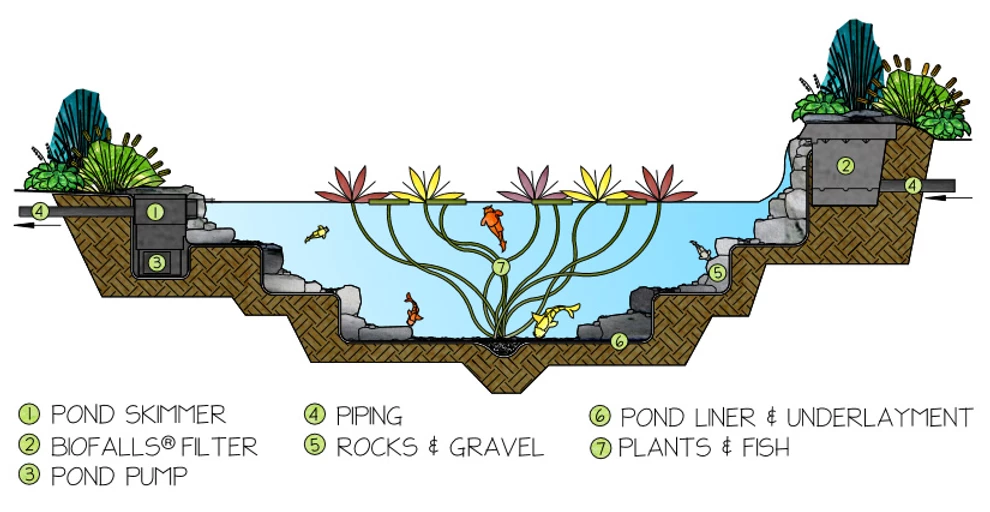The 5 steps of a balanced ecosystem pond
How does a ecosystem pond work?

Every pond ecosystem possesses its own qualities, conditions, and characteristics, but all ponds have some algae some more than others. An over-abundance of algae is the most frequent problem occurring in British ponds.
The answer however, is to find the balance that Mother Nature intended, and the algae will stay under control at an acceptable level. Managing the pond ecosystem in a way that is logical and consistent with Mother Nature is a technique that has been proven to be very successful.
Algae problems are most likely the result of an unbalanced pond. To understand this, one needs only to understand that a water garden is an ecosystem of interrelated elements which all play an equally important role. Together these elements work to maintain a natural ecosystem without over-filtering or adding excessive amounts of chemicals to the pond.
Filtration System
Designing and implementing an efficient circulation system ensures that the water is oxygenated and pond debris (including leaves, larvae, floating algae, and anything else that is blown in) will be swept from the pond’s surface and deposited into an easily emptied skimmer basket. Through various forms of mechanical and biological filtration, the aquatic circle of life turns repeatedly in your pond.
Plants
Algae are plants, and all aquatic plants feed off the same nutrients in the water. The more plants you add to your pond, the more the algae will be starved from its food source. Algae growth will be minimized naturally and effortlessly.
A wide variety of aquatic plants are available for your pond. From waterlilies and lotus to marginal plants such as marsh marigold and horsetail, you will never tire of the options available to you.
Fish
Fish fulfil their role in the ecosystem by eating algae. Presuming they’re not overfed, koi will graze on the algae, effectively reducing its growth. Like plants, a variety of pond fish are available for you to introduce to your pond. Large, colourful koi to gold fish and beyond! Fish are a delightful addition to any size water garden.
Rocks and Gravel
Like aquatic plants, the bacteria that live on the rocks and gravel in the pond feed on excess nutrients in the water, reducing the algae by starving it even further. The rocks and gravel not only hide the liner and create a natural-looking setting, but also provide a home for beneficial bacteria. Plant debris, fish waste, decaying organic matter, excess nutrients, or anything else that falls to the bottom of the pond will rest on top of the rocks and gravel. The bacteria living on the rocks and gravel will then go to work, breaking down the waste and debris, cleaning and clearing the water. Mother Nature’s circle of life is amazing, don’t you agree?
Finally … Patience!
It takes between two and six weeks for the bacteria to colonize and actually begin to do their job. Creating a balanced ecosystem does not happen overnight! Like fine wine, ponds mature with age, so do not be surprised or concerned if a new pond begins to grow some algae. Once the plants, fish, and bacteria are established, the algae will decrease, as will the amount of maintenance on the pond.
